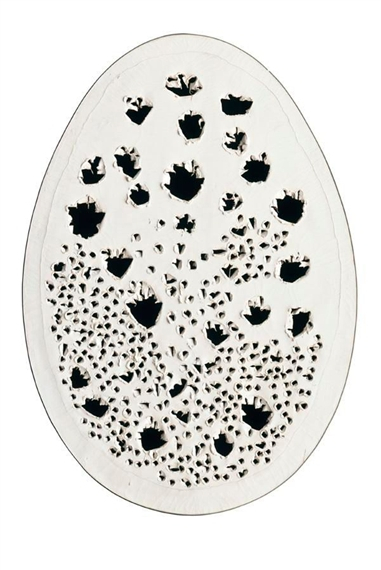Lucio Fontana (1899 - 1968), Concetto spaziale, 1968
Lot 58. Lucio Fontana (1899 - 1968), Concetto spaziale, signed, waterpaint and pencil on canvas, 60.3 by 73.7 cm. 23 3/4 by 29 in. Executed in 1968. Estimate £450,000 - £650,000. Courtesy Sotheby's
Provenance: Brerarte, Milan, 27 May 1985, Lot 57
Private Collection, Milan
Sperone Westwater, New York
Acquired from the above by the present owner in 2005.
Exhibited: Lugano, Galleria Pro Arte , Lucio Fontana: Concetti Spaziali, October - November 1984, p. 15, no. 5 (text)
Tokyo, Fuji Television Gallery, Lucio Fontana, March 1986, n.p., no. 28, illustrated.
Literature: Enrico Crispolti, Fontana: Catalogo Generale, Vol. II, Milan 1986, p. 514, no. 68 B 15, illustrated
Enrico Crispolti, Lucio Fontana, Catalogo Ragionato di Sculture, Dipinti, Ambientazioni, Vol. II, Milan 2006, p. 705, no. 68 B 15, illustrated.
Note: “The discovery of the cosmos is that of a new dimension, it is the infinite: thus I pierce this canvas, which is the basis of all arts and I have created an infinite dimension, an x which for me is the basis for all contemporary art."
Lucio Fontana cited in: Exh. Cat., New York, Solomon R. Guggenheim Museum, Lucio Fontana, Venice/ New York, 2006, p. 19
Executed in the final year of Lucio Fontana’s life, Concetto spaziale encapsulates the Italian artist’s painterly explorations into the mysterious dimensions of the cosmos. A series of small holes perforates the white, monochromatic expanse of the painting, hinting at a dark abyss of enigmatic space beyond the picture plane. Appearing like a constellation of stars, these holes, or buchi, signify one of the great hallmarks of Fontana’s distinctive visual language. In the present work, they are arranged in structured rows within the confines of an oval outlined in pencil. Fontana began working on this cycle of paintings in 1949, and the buchi continued to preoccupy him for the rest of his prolific career. Stemming from one of the most profound periods of his spatial investigations, the buchi represent both a physical and metaphorical manifestation of the infinitude of the universe. As the artist proclaimed in 1963: “I am seeking to represent the void. Humanity, accepting the idea of Infinity has already accepted the idea of Nothingness. And today Nothingness is a mathematical formula” (Lucio Fontana in conversation with Nerino Minuzzo in: l’Europeo, No. 949, Milan 1963).
Lucio Fontana in his studio, Milan, 1960. Image: © Photo Ugo Mulas © Ugo Mulas Heirs. All rights reserved. Artwork: © Lucio Fontana/SIAE/DACS, London 2019
By the time Concetto spaziale was painted in 1968, the world had seen a spate of rapid advancements in science and technology. Indeed, over the course of Fontana’s lifetime, Albert Einstein would publish his ground-breaking Theory of Relativity, the first artificial satellite would be sent soaring above the Earth’s atmosphere, and, in 1961, the Russian Cosmonaut Yuri Gagarin would become the first human being to journey into the cosmic depths of outer space. Fontana’s practice was deeply influenced by these radical developments in space travel, and the oval form in the present work seems to evoke Gagarin’s orbiting trajectory. Discovering and investigating the great unknown realms of the universe was at once an exhilarating and disturbing prospect for Fontana, and his abstract buchi paintings seek to capture something of this simultaneous sense of euphoria and existential angst. The serenity of the pure white surface is juxtaposed by the violent sequence of holes which perforate the canvas, instilling the work with an intrinsic duality which leaves the viewer “alone in the face of everything, curious about everything, on the edge of everything” (Enrico Crispolti, Ed., Fontana, Milan 1999, p. 14). Placed within the central organic shape, the punctures lead the eye hypnotically across the canvas, forcefully opening its surface up to a multi-dimensional play of light and shadow, space and depth.
Lucio Fontana, Concetto Spaziale, La Fine di Dio, 1963. Artwork: © Lucio Fontana/SIAE/DACS, London 2019.
In works such as the present, Fontana dissects the very concept of painting, undermining forever the flat picture plane: “I make a hole in the canvas”, he declared in his last recorded interview in 1968, “in order to leave behind the old pictorial formulae, the painting and the traditional view of art, and I escape, symbolically, but also materially, from the prison of the flat surface” (Lucio Fontana in conversation with Tommaso Trini, 19 July 1968 in: Exh. Cat., Amsterdam, Stedelijk Museum (and travelling) Lucio Fontana, 1988, p. 34). Drawing the viewer into a state of reflexive contemplation, Concetto spaziale gives way to limitless spatial possibilities as it alludes to a cosmic understanding of nature.
Sotheby's. Contemporary Art Evening Auction, London, 05 march 2019, 07:00 PM

/https%3A%2F%2Fprofilepics.canalblog.com%2Fprofilepics%2F1%2F0%2F100183.jpg)
/https%3A%2F%2Fstorage.canalblog.com%2F03%2F02%2F119589%2F96711876_o.jpg)
/https%3A%2F%2Fstorage.canalblog.com%2F11%2F31%2F119589%2F94773502_o.jpg)
/https%3A%2F%2Fstorage.canalblog.com%2F20%2F83%2F119589%2F94772815_o.jpg)
/https%3A%2F%2Fstorage.canalblog.com%2F26%2F72%2F119589%2F75604929_o.jpg)
/https%3A%2F%2Fstorage.canalblog.com%2F59%2F60%2F119589%2F26458628_o.jpg)





/image%2F1371349%2F20240313%2Fob_3da818_431115881-1632814154155264-57534444325.jpg)
/image%2F1371349%2F20240312%2Fob_cc9c83_f2.jpg)
/image%2F1371349%2F20240311%2Fob_2edda2_fontana.jpg)
/http%3A%2F%2Fstorage.canalblog.com%2F86%2F67%2F119589%2F129815803_o.png)